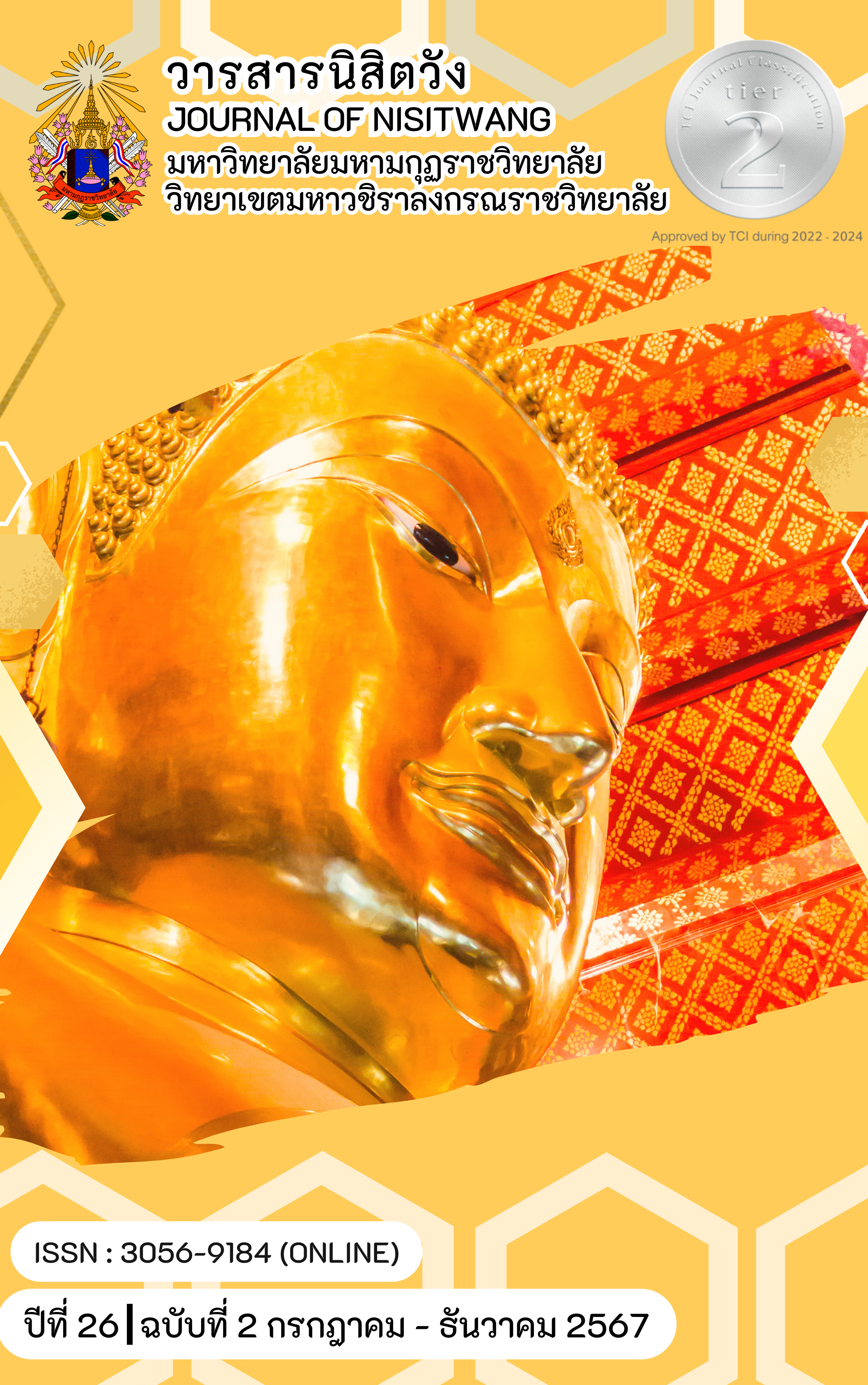DIAGNOSIS OF MATHEMATICAL MISCONCEPTIONS ABOUT RATIO, PROPORTION, AND PERCENTAGE OF MATTHAYOM SUKSA STUDENTS
Main Article Content
Abstract
This research aims to study mathematical misconceptions among Matthayom Suksa one students focusing on ratios, proportions and percentages. The sample group comprised Matthayom Suksa one students who studied at Chulalongkorn University Demonstration School, Secondary Division, Ministry of Higher Education, Science, Research and Innovation in the second semester of the academic year 2023, one classroom with 23 students in total. The students were selected using cluster sampling. The research tool utilized was a diagnostic test on mathematical misconceptions regarding ratios, proportions, and percentages. The test was used in the form of a parallel structured test with four multiple-choice options, consisting of 38 items ranging in difficulty from .317 to .863 with paired items having similar levels of difficulty. The test's discrimination power ranged from .206 to .620 with paired items having similar discrimination power. The test's reliability coefficient was .908. Statistical analysis used in this study include frequency and percentage.
The results illustrated the mathematical misconceptions about ratios, proportions, and percentages of Matthayom Suksa one students as follows :
- Mathematicalmisconceptions in terms of conceptual understanding, the lowest percentage of students with misconceptions was 21.74%, and the highest percentage of students with misconceptions was 56.52%.
- Mathematical misconceptions in terms of interpretation, the lowest percentage of students with misconceptions was 8.70%, and the highest percentage of students with misconceptions was 47.83%.
- Mathematical misconceptions in termsof computation, the lowest percentage ofstudents with misconceptions was 8.70%, and the highest percentage of students with misconceptions was 26.09%.
Article Details
References
จงกล ทำสวน. (2548). การวินิจฉัยข้อผิดพลาดทางการเรียนคณิตศาสตร์ของนักเรียนชั้นมัธยมศึกษาปีที่ 2 โรงเรียน สาธิตจุฬาลงกรณ์มหาวิทยาลัย ฝ่ายมัธยม. Journal of Education Studies, 33 (3), 100-110. DOI: 10.58837/CHULA.EDUCU.33.3.10.
นพพร แหยมแสง และอุไร ซิรัมย์. (2561). พฤติกรรมการสอนคณิตศาสตร์ 1. กรุงเทพฯ : มหาวิทยาลัย รามคำแหง.
พรพรรณ โตโภชนพันธุ์. (2565). การสร้างแบบทดสอบวินิจฉัยหลายตัวเลือกสี่ลำดับขั้น เพื่อศึกษามโนทัศน์ที่คลาดเคลื่อนในวิชาคณิตศาสตร์ เรื่อง จำนวนตรรกยะ ของนักเรียนชั้นมัธยมศึกษาปีที่ 1. วิทยานิพนธ์การศึกษามหาบัณฑิต มหาวิทยาลัยศรีนรินทรวิโรฒ.
พัชรา ผาลิบุตร และนพพร แหยมแสง. (2565). การศึกษาข้อบกพร่องและมโนทัศน์ที่คลาดเคลื่อนทางคณิตศาสตร์ เรื่อง อัตราส่วนและร้อยละ ของนักเรียนชั้นประถมศึกษาปีที่ 6 โรงเรียนสังวาลย์วิท 7. การศึกษาอิสระปริญญามหาบัณฑิต มหาวิทยาลัยรามคำแหง.
ไพจิตตรี กรชม. (2562). การสร้างแบบทดสอบวินิจฉัยวิชาคณิตศาสตร์ เรื่อง บทประยุกต์ สำหรับนักเรียนชั้น
ประถมศึกษาปีที่ 6. วิทยานิพนธ์วิทยาศาสตรมหาบัณฑิต มหาวิทยาลัยบูรพา.
ไพฑูรย์ เอื้อบุญประดิษฐ์. (2563). การพัฒนาแบบสอบวินิจฉัยการรู้เรื่องคณิตศาสตร์ที่มีการให้ข้อมูลย้อนกลับสำหรับนักเรียนชั้นมัธยมศึกษาปีที่ 3 โดยใช้วิธีลำดับขั้นของคุณลักษณะ. วิทยานิพนธ์ครุศาสตรดุษฎี
บัณฑิต จุฬาลงกรณ์มหาวิทยาลัย.
สถาบันทดสอบทางการศึกษาแห่งชาติ. (2563). รายงานผลการทดสอบทางการศึกษาระดับชาติขั้นพื้นฐาน (O-NET) ชั้นมัธยมศึกษาปีที่ 3 ปีการศึกษา 2563 ฉบับที่ 2–ค่าสถิติแยกตามมาตรฐานการเรียนรู้สำหรับโรงเรียน [เอกสารไม่ได้ตีพิมพ์]. หน่วยทะเบียนและประเมินผล, โรงเรียนสาธิตจุฬาลงกรณ์มหาวิทยาลัย ฝ่ายมัธยม.
สถาบันทดสอบทางการศึกษาแห่งชาติ. (2564). รายงานผลการทดสอบทางการศึกษาระดับชาติขั้นพื้นฐาน (O-NET) ชั้นมัธยมศึกษาปีที่ 3 ปีการศึกษา 2564 ฉบับที่ 2–ค่าสถิติแยกตามมาตรฐานการเรียนรู้สำหรับโรงเรียน [เอกสารไม่ได้ตีพิมพ์]. หน่วยทะเบียนและประเมินผล, โรงเรียนสาธิตจุฬาลงกรณ์มหาวิทยาลัย ฝ่ายมัธยม.
สถาบันทดสอบทางการศึกษาแห่งชาติ. (2565). รายงานผลการทดสอบทางการศึกษาระดับชาติขั้นพื้นฐาน (O-NET) ชั้นมัธยมศึกษาปีที่ 3 ปีการศึกษา 2565 ฉบับที่ 2–ค่าสถิติแยกตามมาตรฐานการเรียนรู้สำหรับโรงเรียน [เอกสารไม่ได้ตีพิมพ์]. หน่วยทะเบียนและประเมินผล, โรงเรียนสาธิตจุฬาลงกรณ์มหาวิทยาลัย ฝ่ายมัธยม.
สำนักงานคณะกรรมการการศึกษาขั้นพื้นฐาน. (2551). หลักสูตรแกนกลางการศึกษาขั้นพื้นฐาน พุทธศักราช 2551. กรุงเทพฯ : โรงพิมพ์ชุมนุมสหกรณ์การเกษตรแห่งประเทศไทย จำกัด.
สำนักงานคณะกรรมการการศึกษาขั้นพื้นฐาน. (2560). ตัวชี้วัดและสาระการเรียนรู้แกนกลาง กลุ่มสาระการเรียนรู้
คณิตศาสตร์ (ฉบับปรับปรุง พ.ศ.2560) ตามหลักสูตรแกนกลางการศึกษาขั้นพื้นฐาน พุทธศักราช 2551.
กรุงเทพฯ : โรงพิมพ์ชุมนุมสหกรณ์การเกษตรแห่งประเทศไทย จำกัด.
_______. (2565). (ร่าง) กรอบหลักสูตรการศึกษาขั้นพื้นฐาน พุทธศักราช ... ระดับประถมศึกษา. [Online]. Available : https://cbethailand.com/download/6671/. [2024, April 2].
อัมพร ม้าคนอง. (2545). การวินิจฉัยข้อผิดพลาดทางการเรียนคณิตศาสตร์ของนักเรียนชั้นมัธยมศึกษาปีที่ 5 โรงเรียน สาธิตจุฬาลงกรณ์มหาวิทยาลัย. Journal of Education Studies, 30 (3), 15–20. DOI: 10.58837/CHULA.EDUCU.30.3.2.
อุไรวรรณ ศรีไชยมูล. (2554). การวิเคราะห์มโนทัศน์ที่คลาดเคลื่อนและข้อผิดพลาดทางการเรียนคณิตศาสตร์ เรื่อง อัตราส่วนและร้อยละ ของนักเรียนชั้นมัธยมศึกษาปีที่ 2. วิทยานิพนธ์ครุศาสตรมหาบัณฑิต
มหาวิทยาลัยราชภัฏมหาสารคาม.
Arican, M. (2018). A diagnostic assessment to middle school students' proportional reasoning. Turkish Journal of Education, 8 (4), 237–257. DOI: 10.19128/turje.522839.
Ben-Chaim, D., et al. (2012). Ratio and Proportion: Research and Teaching in Mathematics
Teachers' Education (Pre- and In-Service Mathematics Teachers of Elementary and Middle School Classes). Rotterdam, Sense Publishers.
Güler-Okumuş, M. and Güveli, E. (2023). Elimination of misconceptions about percentages with the cognitive conflict approach. Journal of Computer and Education Research, 11 (21), 162-193. https://doi.org/10.18009/jcer.1223434.
Hamza Cahsici. (2018). Middle School Students' Learning Difficulties in the Ratio-proportion Topic and a Suggested Solution: Envelope Technique. Universal Journal of Education Research, 6 (8). DOI: 10.13189/ujer.2018.060830.
Kaplan, A., et al. (2011). The misconceptions in ratio and proportion concept among 6th grade students. Kastamonu Education Journal, 19 (3), 953-968.
Shoaib, A. and Akhter, M. (2020). Diagnosing high school students' mathematics misconceptions. International Review of Social Sciences, 8 (12), 368-385.


